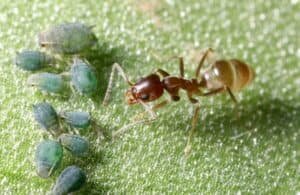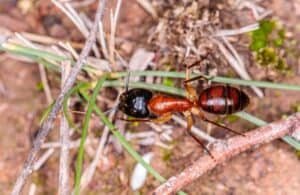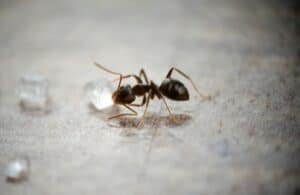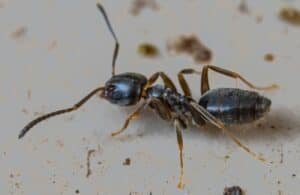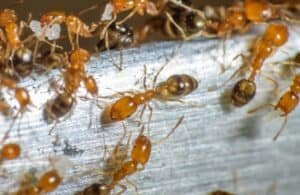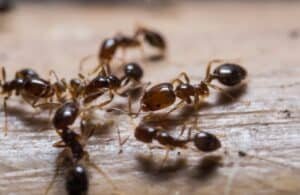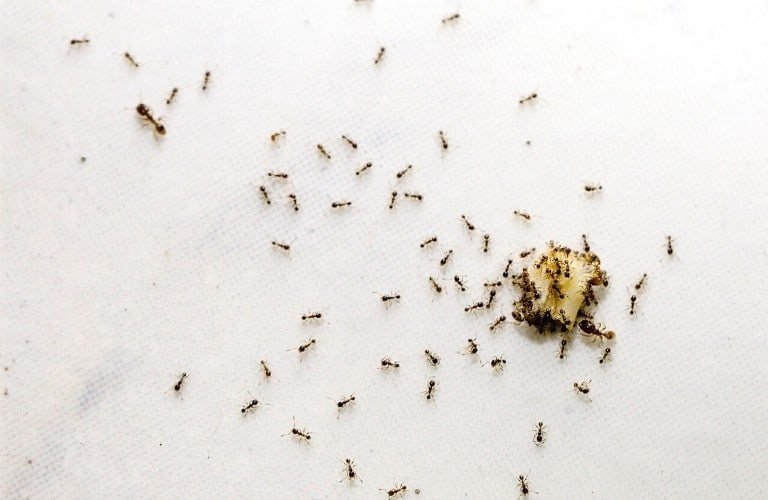Once ants find their way onto your porch or into your yard or home, they can be difficult to get rid of.
They might be small, but getting rid of them can be challenging when the entire colony is trailing in cabinets, up the walls, and across your counters.
How do you get rid of ants? In addition to removing food sources, use natural products, such as boiling water, neem oil, and diatomaceous earth outdoors. Indoors, use boric acid, borax, essential oils, or cornstarch. Pesticides such as aerosol or liquid sprays and bait traps can be used as well.
Let’s take a look at the best ways to get rid of ants inside and outside your home.
Identification
Ants are hard to miss, especially when the whole colony is out foraging.
From afar, they look like little red, brown, or black dots scurrying around, but up close they’re actually intricately detailed.
They have three sections on their body (head, thorax, and abdomen), six legs, two antennae, and pincers at their mouth that they use to eat and bite.
Some ants might have wings and will be confused with termites, but they’re actually an alate – a member of the ant colony that’s responsible for mating.
These ants are only around about once per year and won’t live for very long. Should you be concerned if you spot a swarm of winged ants? Find out here.
Every member of an ant colony has a specific job to do, and it can be fascinating to watch them scurry about their duties.
Even the way ants rest is interesting. No eight hours of beauty sleep for these hard workers. Learn how and for how long ants actually sleep in this article.
Only 12,500 species of ants have been identified, but it’s estimated that there are about 22,000 species in total around the world.
You may not be able to identify every single ant, but here are some of the most common ones.
Common Ants
Argentine Ant
This species is no more than 3 millimeters long and can fit in some of the smallest cracks. They’re usually dark yellow or light brown.
They like to nest in manmade buildings and under rocks.
They’re native to Brazil but have been introduced to nearly every continent. They’re found in the U.S., including Hawaii.
Banded Sugar Ant
Some banded sugar ants can be as big as 15 millimeters. They’re typically black and reddish-brown. They’re nocturnal and usually live in forest areas.
Carpenter Ant
Carpenter ants build their nest in wood by chewing holes through it, which is how they get their name. They don’t eat the wood, however.
These ants are typically between 6 and 20 millimeters long. They’re most often black with long legs, though color can vary.
European Fire Ant
The European fire ant is native to Europe but has become an invasive species in North America. It’s a reddish color and just a few millimeters in size.
They can bite and sting and often do, leaving behind an itchy, painful, fluid-filled, tiny blister.
Did you know that all ants are capable of biting? It’s true. You’ll find more details and learn how to best treat a bite in this article.
Pavement Ant
The pavement ant, or sugar ant, is the most common ant in North America. It’s small and black and makes its nest under concrete.
If you see tiny black ants around your home, it’s probably this kind or one of several species collectively referred to as sugar ants.
Check out this article to learn more about sugar ants and how to get rid of them.
Odorous House Ant
Odorous house ants are either brown or black and are no more than 3 millimeters in size.
They’re native to North America and release a foul odor often described as being similar to that of rotting coconut when crushed.
They’re commonly found in houses, which is how they get their name.
Pharaoh Ant
Pharaoh ants are a yellowish-brown and only 2 millimeters long.
They can be found on almost every continent and are major pests in North America, Europe, and Australia and are commonly found in hospitals.
Red Ant
The red ant is also called a horse ant or southern wood ant. It’s native to Europe but can be found in North America as well.
They can measure up to 9 millimeters long and are red and black. They usually live in woodland areas with sun exposure.
Red Imported Fire Ant
This RIFA, or fire ant, is native to South America but has been introduced to several countries around the world.
They were introduced to the USA around 1940 and have become a terribly invasive species. They can measure up to 6 millimeters long.
They’re usually red but can also have brown or black parts on their body.
Yellow Crazy Ant
The yellow crazy ant is native to Asia but can now be found in almost every tropical region in the world. It has long legs and is a yellowish-brown color.
It’s officially one of the world’s 100 worst invasive species since they’re endangering red crabs and the rainforest on Christmas Island.
Removal Methods
| Method | Estimated Cost | Natural | Odor-Free |
| Citrus peels | $5 | ✅ | |
| Vinegar | $4 | ✅ | |
| Coffee grounds | $5 | ✅ | ✅ |
| Spices | $5 | ✅ | |
| Boric Acid | $6 | ✅ | ✅ |
| Borax | $10 – $30 | ✅ | ✅ |
| Essential oils | $7+ | ✅ | |
| Cornstarch | $6 | ✅ | ✅ |
| Neem oil | $20 | ✅ | |
| Boiling water | $0 | ✅ | ✅ |
| Diatomaceous earth | $10 | ✅ | ✅ |
| Aerosol Spray | $10 | ||
| Liquid Spray | $20 | ||
| Bait Traps | $10 | ✅ | |
| Boiling Water | ✅ | ✅ |
The Best Way to Eliminate Ants
The best way to get rid of ants is to make a DIY bait with boric acid. Boric acid isn’t too expensive and is easily available to purchase online.
Boric Acid is a great inexpensive option. It’s only half a pound, so you won’t be left with too much extra once you’re done.
To make the bait, follow these steps:
- Add ½ – 1 teaspoon of boric acid to a container.
- Add 2-3 tablespoons of a sugary substance such as honey, maple syrup, or corn syrup.
- Mix the ingredients together until it creates a paste.
- Place the paste on a flat disposable surface like a piece of paper or cardboard. Leave the bait near where you find the most ants.
This method works best indoors, but it can also work outside as long as you keep it in a protected area so it won’t get blown away or ruined by the rain.
The ants will take the bait back to the anthill and it will eventually kill them as they eat.
Basic Guidelines
If you take a few steps to prevent ants, it’ll save you a lot of trouble in the long run.
Prevention methods don’t guarantee an ant-free home, but they can greatly reduce the number you see.
Remove Food Sources
Ants are attracted to food. A single crumb on the ground can be enough to attract a swarm from the nearest colony.
You can prevent ants from coming in by making sure there isn’t any food available to them with the following methods:
- Sweep and vacuum regularly.
- Clean underneath couch cushions.
- Wash trash bins frequently.
- Clean kitchen counters and dining tables every time you use them.
- Pick up all food outside after a cookout or picnic.
Remove Plants Touching Your Home
Trees and vines that touch your home can easily become bridges for tiny ants.
They can crawl onto your roof and make their way into your attic and walls. Trim trees and vines all around your home to make sure there’s no connection.
Deter Ants with Natural Remedies
Ants love food, but there are plenty of smells that they hate. You can take these ingredients from your fridge or pantry and use them to your advantage:
- Citrus peels and juice.
- White vinegar.
- Coffee grounds.
- Peppermint.
- Black pepper.
You can mix these ingredients with water to create a spray, or you can sprinkle the ingredients around the home.
If you keep house plants, sprinkling these ingredients on top of the dirt or at the base of the pot will help keep ants from building nests in the soil.
Natural Solutions to Get Rid of Ants
Even the most vigorous prevention attempts can result in the occasional infestation. Don’t feel defeated – ants are some of the most determined critters.
If you see a line of ants crawling through or toward your home, there are plenty of natural ways you can get rid of them.
Always try natural methods before you turn to pesticides because they’re safer for the environment and for yourself.
Indoor Infestations
Indoor infestations can be the most annoying since ants aren’t supposed to be inside your home.
They usually infest kitchens since that’s where the most food is, but they can come into any room where crumbs have been left behind.
Boric Acid and Borax
A common misconception is that boric acid and borax are the same things, but they’re not.
They’re often confused because they can be used in similar ways and they’re both great methods of pest control.
In fact, many pesticides rely on boric acid as the main ingredient.
These ingredients work best as a paste mixed with sugar. The ants are drawn toward it for the sugar, so they eat it and take some back to their nest.
Eventually, the ants will die after they eat the poisonous substance.
It might take several weeks, but boric acid can kill an entire colony if all of the ants, including the queen, eat it.
Florida Labratories Boric Acid is more than 99.9% pure and is highly recommended for pest treatments such as this.
If you’d rather use borax, Pure Organic Ingredients Borax comes in a 1 gallon bucket and contains 9 pounds of pure borax powder.
That will be more than enough for multiple batches of ant treatment and plenty for use with laundry and household cleaning.
Method 1:
- ½ – 1 teaspoon of boric acid or borax (no need for both)
- 2-3 tablespoons of sugar
- 1 cup of warm water
Mix the boric acid or borax and sugar into the water until it’s dissolved. Dip cotton balls in the solution and place them near where the ants show up.
Method 2:
- ½ – 1 teaspoon of boric acid or borax
- 2-3 tablespoons of maple syrup, corn syrup, or honey
Mix both ingredients together so that it forms a paste. Place the mixture on a flat surface such as a piece of cardboard or paper and place it where the ants will find it.
Both options will attract the ants, then they will pick up the food and take it to their nest, which will slowly kill them over time.
Method 2 might be more effective for long-term control since the ants will have more food to pick up than what will be on the cotton ball.
Essential Oils
Essential oils are a great way to deter ants.
You can either add a few drops of oil to a few cotton balls and place them near the areas where ants show up or you can mix the oil with water and spray down the areas.
Essential oils you can use include:
- Eucalyptus.
- Peppermint
- Oil of lemon eucalyptus (OLE).
- Tea tree.
This Cliganic Essential Oils Set is a great starter set of essential oils you can use to get rid of ants.
This set doesn’t include oil of lemon eucalyptus, but it does have peppermint, eucalyptus, and tea tree oil.
You can mix these with others to create scents you enjoy so you can freshen up your home while you’re battling ants.
To make a spray, start with 15-25 drops of oil per 4 ounces of water. You can make it stronger if you’d like, but it’s better to start out small and change it from there.
Cornstarch
Cornstarch is a quick and easy way to kill ants on contact. This is a messy process, so make sure electronics and other valuables are out of the way.
Whether the ants are swarmed around some food or they’re following their trail, pour cornstarch all over them.
There’s no need to pour the entire container, but you should use enough that it creates a thick layer.
You probably have cornstarch on hand, but if you don’t, Unpretentious Baker Corn Starch is a food-grade cornstarch with a screwing shaker lid.
Whatever you don’t use for ants, you can use it in cooking and baking.
Once you poured the cornstarch, pour water on top of it. It will create a paste and smother them, and soon you’ll have a pile of gooey cornstarch and dead ants.
This method works best for large groups, and it’s a quick and easy way to get rid of them. You can clean them up with a paper towel or rag.
Outdoor Infestations
It’s best to use natural solutions outside since ants are usually found around plants and other animals.
If you’re having a cookout in your yard, natural solutions will be safe to use around family and company, so you won’t have to clear the area if you spot some ants.
Note: If ants aren’t close to your home and aren’t bothering anybody, it’s best to let them be. They’re actually one of the most beneficial insects in the world.
Find out what roles ants perform in nature here.
Neem Oil
Neem oil is oil from a tree that acts as a pest repellent. You can apply it directly on plant leaves, around anthills, or anywhere the ants are bothering you.
Neem oil does have an odor, but you might not notice it outside.
The Neem Co. Neem Oil is pure, undiluted neem oil that’s organic. It’s great to use as a defense against ants, and you can also use it for cosmetic purposes.
Boiling Water
Boiling water is an incredibly simple solution to kill ants directly at the source. Pour a pot of water over an anthill to quickly get rid of them.
It will act as a quick short-term solution but might not get rid of the problem completely.
Try pouring two or three pots of water over the area to make it more effective.
Diatomaceous Earth
Diatomaceous earth is a powder made of fossilized algae.
It’s perfectly safe for humans to use, but as insects walk across it, it tears up their exoskeletons and causes them to dehydrate and die.
This powder is a simple way to kill large populations of ants. You can sprinkle it on the ground wherever you see ants crawling, and it will slowly kill them all.
Harris Diatomaceous Earth is an organic product that’s safe to use around people and pets. It’s a good option if you want to use it in vegetable gardens or anywhere in your backyard.
Pesticide Solutions to Get Rid of Ants
Sometimes ant populations expand so quickly that natural remedies don’t even bother them.
If you have a severe problem that’s making you uncomfortable in your own home, pesticides or an exterminator are probably the better options to choose.
Don’t miss out on other outdoor ant solutions. Head over to our article “Best Outdoor Ant Killer” for additional options.
Keep in mind that pesticides are harmful to all living beings. They are meant to kill pests, after all.
Aerosol Spray: Terro Outdoor Ant Killer Spray
Aerosol spray pesticides kill ants on contact within minutes. They work well if you spot ants around your doors, on your patio, or near your grill.
If you spray the area and remove the food source, you have a good chance of keeping ants away for a while.
Since it kills on contact, you’re not getting rid of the source of ants and are bound to see more eventually.
Terro Outdoor Ant Killer Spray is meant to be used outdoors against ants, spiders, roaches, and other pests.
It can spray up to 15 feet and will kill ants in a matter of minutes. Be sure to protect your face and skin when using the product, so it doesn’t spray back in your face.
Liquid Spray: Ortho Home Defense Insect Killer
Liquid sprays are different than aerosol sprays because you have more control over where the pesticide is applied, and the residue can stick around longer, so more ants will get killed.
Ortho Home Defense Insect Killer can work for up to one year after it’s sprayed, as long as the residue doesn’t get washed away with water.
Ortho Home Defense is meant to be used around the perimeter of your home. There are other kinds that can be applied elsewhere too.
Although liquid sprays offer more control, you’ll still need to protect your skin for safety.
Bait Traps: Terro Liquid Ant Baits
If you don’t want to risk getting chemicals on you or don’t want residue everywhere, bait traps might be the best option for you.
These products contain substances similar to the sugar and boric acid mixture mentioned previously.
They attract ants to them so that they’ll take the food back to their colony, which will eventually kill all the other ants.
Terro Liquid Ant Baits are ready to use right out of the box. They have stakes you can attach to the bottom so you can secure them into the ground.
You can place them near anthills or near where they’re congregating by your house.
They should last in the box for a year or two and can still be used once they dry out, provided you fill them with a homemade mixture.
Safety Precautions When Using Pesticides
All pesticides, even if they’re a simple bait or trap, have harmful chemicals in them.
When you use them, wear protective gear that will protect your skin and eyes and prevent you from breathing in the chemicals.
Keep children and pets away from the area when you’re applying pesticides, and don’t let them return until it has dried completely.
Following the directions on the packaging to make sure you’re using them safely.
When to Call a Professional Exterminator
If your ant problem has gotten out of control or none of these methods seem to work, it’s time to call a professional.
An exterminator will be able to survey the area and see which method will work best for both short-term and long-term control.
Before you make the appointment, be sure to check with all of our ant articles (click here) for other elimination methods to try before spending money on a professional service.
Image credit: Odorous house ant – Lee Alloway



